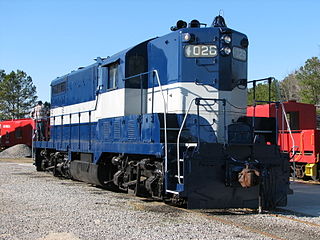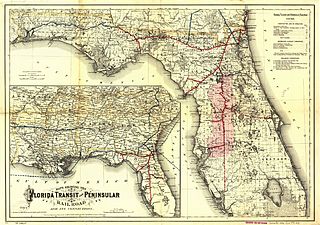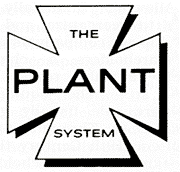
The Atlantic Coast Line Railroad was a United States Class I railroad formed in 1900, though predecessor railroads had used the ACL brand since 1871. In 1967 it merged with long-time rival Seaboard Air Line Railroad to form the Seaboard Coast Line Railroad. Much of the original ACL network has been part of CSX Transportation since 1986.

The Georgia Railroad and Banking Company also seen as "GARR", was a historic railroad and banking company that operated in the U.S. state of Georgia. In 1967 it reported 833 million revenue-ton-miles of freight and 3 million passenger-miles; at the end of the year it operated 331 miles (533 km) of road and 510 miles (820 km) of track.

The Florida Central and Peninsular Railroad was the final name of a system of railroads throughout Florida, becoming part of the Seaboard Air Line Railway in 1900. The system, including some of the first railroads in Florida, stretched from Jacksonville west through Tallahassee and south to Tampa. Much of the FC&P network is still in service under the ownership of CSX Transportation.

The Plant System named after its owner, Henry B. Plant, was a system of railroads and steamboats in the U.S. South, taken over by the Atlantic Coast Line Railroad in 1902. The original line of the system was the Savannah, Florida and Western Railway, running across southern Georgia. The Plant Investment Company was formed in 1882 to lease and buy other railroads and expand the system. Other major lines incorporated into the system include the Savannah and Charleston Railroad and the Brunswick and Western Railroad.
The Wilmington and Weldon Railroad (W&W) name began use in 1855, having been originally chartered as the Wilmington and Raleigh Railroad in 1834. When it opened in 1840, the line was the longest railroad in the world with 161.5 miles (259.9 km) of track. It was constructed in 4 ft 8 in gauge. At its terminus in Weldon, North Carolina, it connected with the Seaboard and Roanoke Railroad and the Petersburg Railroad. The railroad also gave rise to the city of Goldsboro, North Carolina, the midpoint of the W&W RR and the railroad intersection with the North Carolina Railroad.
The Augusta and Knoxville Railroad (A&K) was a railroad company that operated on 66 miles (106 km) of track between Augusta, Georgia, and Greenwood, South Carolina, from 1882 to 1886. It was merged with three other companies to form the Port Royal and Western Carolina Railway, which was reorganized in 1896 as the Charleston and Western Carolina Railway.
The Piedmont & Northern Railway was a heavy electric interurban company operating over two disconnected divisions in North and South Carolina. Tracks spanned 128 miles (206 km) total between the two segments, with the northern division running 24 miles (39 km) from Charlotte, to Gastonia, North Carolina, including a three-mile (5 km) spur to Belmont. The southern division main line ran 89 miles (143 km) from Greenwood to Spartanburg, South Carolina, with a 12 mi (19 km) spur to Anderson. Initially the railroad was electrified at 1500 volts DC, however, much of the electrification was abandoned when dieselisation was completed in 1954.

The Carolina Piedmont Railroad is a class III railroad and subsidiary of Genesee & Wyoming Inc. operating in the Upstate region of South Carolina. From an interchange with CSX Transportation at Laurens the railroad runs 34 miles (55 km) to the northwest, terminating at East Greenville.
The McCormick Subdivision is a railroad line owned and operated by CSX Transportation in the U.S. states of Georgia and South Carolina. The line runs from Augusta, Georgia, to Greenwood, South Carolina, for a distance of 62.8 miles (101.1 km). At its south end the line continues north from the Augusta Subdivision and at its north end the line continues north as the Monroe Subdivision.
The Port Royal and Augusta Railway was a South Carolina railroad that existed in the latter half of the 19th century.
The Port Royal and Western Carolina Railway (PR&WC) was a railroad company in the southern United States that operated on 229 miles (369 km) of 4 ft 9 in gauge track. It was formed in 1886 by the merger of the Augusta and Knoxville Railroad, Greenwood, Laurens and Spartanburg Railroad, Savannah Valley Railroad and the Greenville and Laurens Railroad, which then joined with Port Royal and Augusta Railway.
The Wilmington and Manchester Railroad was a railroad that served South Carolina and North Carolina before, during and after the American Civil War. It received its charter in 1846 and began operation in 1853 from Wilmington, North Carolina, extending west to the now-defunct town of Manchester, South Carolina. The track gauge was 5 ft.
The Greenwood, Laurens and Spartanburg Railroad was a South Carolina railroad company begun after Reconstruction.
The Andrews Subdivision is a railroad line owned by CSX Transportation in North Carolina and South Carolina. The line is a former Seaboard Air Line Railroad line that runs from Hamlet, North Carolina, to Charleston, South Carolina, for a total of 156.6 miles. At its north end it continues south from the Hamlet Terminal Subdivision and at its south end it connects to CSX's A Line.
The Augusta Subdivision is a railroad line owned by CSX Transportation in the U.S. states of Georgia and South Carolina. The line runs from Augusta, Georgia, to Yemassee, South Carolina, for a total of 87.7 miles (141.1 km). At its north end it continues south from the McCormick Subdivision and at its south end it continues south as the Charleston Subdivision.
Augusta Union Station was a train depot in Augusta, Georgia at 525 8th Street, serving trains from its opening in 1903 to its closing in 1968. The Spanish Renaissance styled building was in central Augusta at Barrett Square, five blocks from the banks of the Savannah River.

The Atlantic Coast Line Railroad’s Main Line was the backbone of the Atlantic Coast Line Railroad's network in the southeastern United States. The main line ran from Richmond, Virginia to Port Tampa just southwest of Tampa, Florida, a distance of nearly 900 miles. Along its route it passed through Petersburg, Rocky Mount, Florence, Charleston, Savannah, Jacksonville, and Orlando. With the exception of a short 61-mile segment in Greater Orlando, the entire line is still owned by the Atlantic Coast Line's successor, CSX Transportation, and is still in service as their A Line.
The Seaboard Air Line Railroad’s Main Line was the backbone of the Seaboard Air Line Railroad's network in the southeastern United States. The main line ran from Richmond, Virginia to Tampa, Florida, a distance of over 800 miles. Along its route it passed through Petersburg, Raleigh, Columbia, Savannah, Jacksonville, and Ocala, Florida. While some segments of the line have been abandoned as of 2022, most of the line is still in service and is owned by the Seaboard Air Line's successor, CSX Transportation as their S Line.






